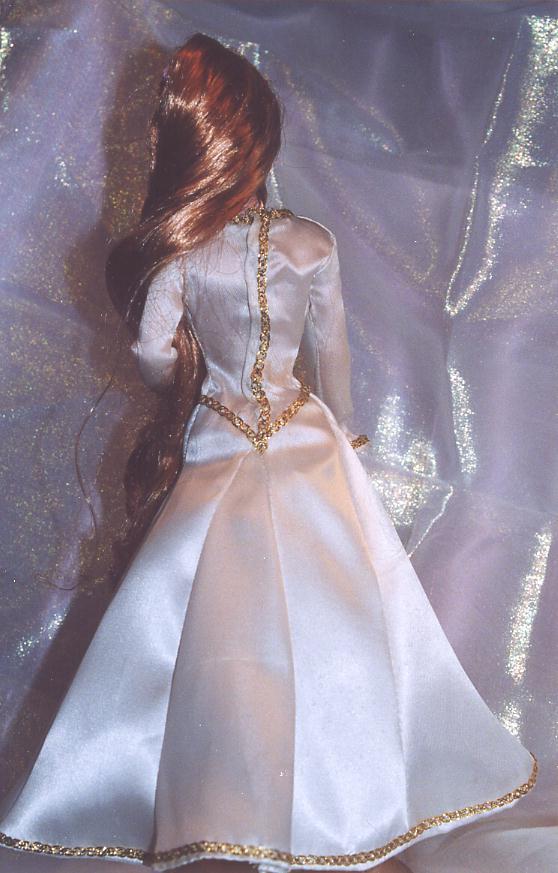 |
 |
 |
 |
 |
 |
 |
|
| Guinevere |

|
Then, in the boyhood of the year,
Sir Launcelot and Queen Guinevere
Rode thro' the coverts of the deer,
With blissful treble ringing clear.
She seem'd a part of joyous Spring;
A gown of grass-green silk she wore,
Buckled with golden clasps before;
A light-green tuft of plumes she bore
Closed in a golden ring.
---Alfred, Lord Tennyson from "Sir Launcelot and Queen Guinevere
This Barbie make-over and design portrays Guinevere from Arthurian legend acting as the "Queen of May" for the traditional
Celtic May Day celebrations. May Day was celebrated from early Celtic and Anglo-Saxon times, through the Medieval period
and even to modern times, as a celebration of spring and the renewed fertility of the land after the long, dark winter. Young
people would gather flowering boughs and wild-flowers to present to the loveliest lady who, decked in flowers and ribbons,
presided over the festivities.
Arthurian legend itself is full of images of the king and queen as representing and ensuring the fertility of the land, and
Guinevere is often depicted as being brought by Lancelot from her father's house to her wedding with Arthur amid the hope
and blooming of Springtime. Queen Guinevere is represented in early myth and medieval courtly romances as the most beautiful
woman of the court and the hostess of its pageantry, so depicting her as the Queen of the May Revels fits this portrayal.
|
 |
|
 |
 |
 |
|
|
|
 |
 |
 |
 |
 |
 |
 |

| Guinevere |

|
The outfit consists of a white satin under-dress or shift, trimmed at the neckline, on the bodice, wrist, and hem with gold
braid; the sleeves and low-waisted bodice are close fitting while the skirt is flared. The over-dress or tunic is of a translucent,
pale green, silky material, with a low-waisted, sleeveless, close-fitting bodice and a gathered, full skirt split in front
to reveal the underdress and with a long, sweeping back. The edges of the armholes and the skirt are trimmed with gold braid,
while the braid trimming the low, v-shaped neckline and the pointed waistline are further embellished with "pearl"
seed-beads. A diamond-shaped, decorative piece in jewel tones and trimmed with green glass beads at the front of the bodice
accentuates the tiny waist and lends a Celtic flare to the gown. The back of the bodice closes with gold ribbon cross-gartered
between pearl buttons.
|
|
 |
 |
 |
|
Greensleeves was my delight,
Greensleeves my heart of gold;
Greensleeves was my heart of joy,
And who but my Lady Greensleeves.
---King Henry VIII
Also serving a decorative function are the detachable over-sleeves, pale green on the outside and white satin on the inside,
trimmed in gold braid, green and lavender "jewels" and coordinating ribbons. These sleeves, worn by fashionable
and wealthy young women, were the chosen tokens of the knights who competed in tournaments. The lady would remove her sleeve,
give it to her selected knight-champion, who would attach it to his helmet, his lance or his own arm to bring him luck in
the joust. This tradition is the basis of the song "Greensleeves" written by the young King Henry VIII. Guinevere,
as Queen of Camelot and Queen of May, wears a golden crown shaped like a wreath of flowers around her head, trimmed with long
satin ribbons coordinating with her outfit. The two long braids on each side of her face were fashionable in the High Medieval
period, and contrast beautifully with the rest of her hair which falls to her knees in soft waves. She also bears a bouquet
of white spring flowers bound with golden ribbon, and on her feet are white shoes trimmed with green "jewels."
|
|
 |
 |
 |








